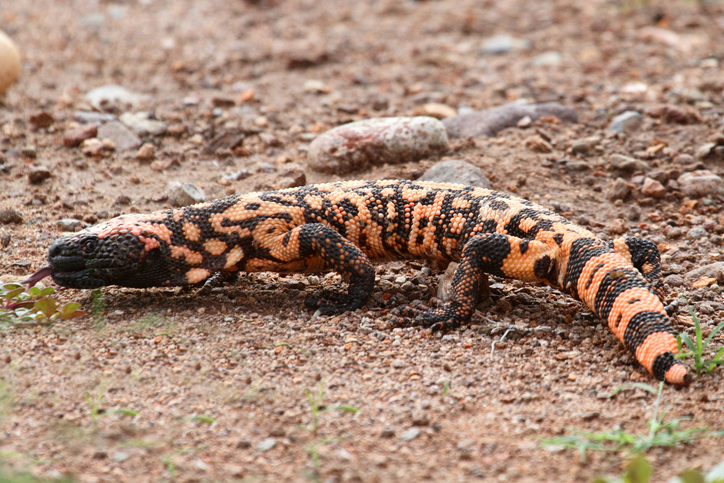Are Gila Monsters Poisonous?

The Gila monster, a striking lizard native to the southwestern United States and northwestern Mexico, often captivates the imagination of those who encounter it. With its vibrant orange and black coloration, this reptile stands out in the desert landscape, but many people wonder about its safety. Are Gila monsters really poisonous? Understanding their biology and behavior is crucial for anyone interested in these unique creatures. This article will explore the venomous nature of Gila monsters, their characteristics, and their role in the ecosystem.
Quick Info Table
| Feature | Description |
|---|---|
| Scientific Name | Heloderma suspectum |
| Habitat | Southwestern U.S., Northwestern Mexico |
| Size | 18 to 22 inches long |
| Diet | Carnivorous (small mammals, birds) |
| Venom Type | Neurotoxic |
| Conservation Status | Near Threatened |
Understanding Gila Monsters
Appearance and Behavior
Gila monsters are easily recognizable due to their distinct patterns. Their skin is covered in bead-like scales, which contribute to their unique look. Typically, an adult Gila monster measures between 18 and 22 inches in length and can weigh up to 5 pounds. Their bright colors serve a dual purpose: they not only help to camouflage them in their arid environment but also act as a warning to potential predators about their toxicity.
These reptiles are primarily nocturnal, becoming active in the cooler evenings when they hunt for food. They are solitary creatures, known for their slow, lumbering movements. Gila monsters spend much of their time in burrows or hidden among rocks and vegetation, emerging mainly to feed and bask in the sun.
Habitat and Distribution
The Gila monster inhabits a range of ecosystems, primarily focusing on desert regions. They are often found in areas with rocky substrates, where they can dig burrows. Their range includes parts of Arizona, New Mexico, Utah, and even Mexico. The species thrives in warm environments, where it can regulate its body temperature effectively.
Are Gila Monsters Poisonous?
The Nature of Their Venom
Contrary to popular belief, Gila monsters are not poisonous; rather, they are venomous. The distinction lies in the method of delivery. Venomous creatures inject toxins through specialized structures, such as fangs, while poisonous organisms release toxins when consumed. Gila monsters possess venom that is delivered through grooves in their teeth, allowing them to inject it into their prey.
The venom of a Gila monster contains neurotoxins, which affect the nervous system. This venom serves multiple purposes: it helps the lizard subdue its prey, which primarily includes small mammals and birds, and it also serves as a defense mechanism against potential predators.
Effects of the Venom
While Gila monster bites can be painful and may cause significant swelling, the venom is not lethal to humans. Symptoms can include intense pain, swelling, and nausea, but fatalities are extremely rare. In fact, only a handful of Gila monster bites have been documented in recorded history, and these incidents are often due to provocation or mishandling of the animal.
Despite their reputation, Gila monsters are generally not aggressive and will only bite if threatened. It is essential to respect their space and appreciate their role in the ecosystem without disturbing them.
The Role of Gila Monsters in the Ecosystem
Predators and Prey
Gila monsters play a vital role in maintaining the balance of their ecosystem. As predators, they help control populations of small mammals and birds. Their diet primarily consists of rodents and birds, which they locate using their keen sense of smell. By keeping these populations in check, Gila monsters contribute to the overall health of their habitat.
Conservation Status
Unfortunately, Gila monsters face threats from habitat loss and human encroachment. As urban areas expand and natural habitats are destroyed, these reptiles struggle to find suitable environments. Additionally, they are sometimes targeted by collectors, further endangering their populations.
Conservation efforts are underway to protect Gila monsters and their habitats. By raising awareness about their ecological importance and educating the public about their behavior, we can promote coexistence and ensure the survival of this remarkable species.
Gila Monsters and Human Interaction
Myths and Misconceptions
Many myths surround the Gila monster, primarily due to its striking appearance and venomous reputation. One common misconception is that all brightly colored animals are dangerous. While it is true that the Gila monster's vibrant colors serve as a warning signal, it is crucial to understand that they are generally not aggressive unless provoked.
How to Coexist with Gila Monsters
For those living in areas where Gila monsters are present, it is essential to know how to interact safely. Here are some tips for coexisting with these fascinating creatures:
- Respect their habitat: Avoid disturbing rocky areas or burrows where Gila monsters may reside.
- Observe from a distance: If you encounter a Gila monster, maintain a safe distance and appreciate its beauty without attempting to handle or provoke it.
- Educate others: Share information about Gila monsters to dispel myths and promote understanding of their role in the ecosystem.
Conclusion
In summary, Gila monsters are indeed venomous, but they are not poisonous in the traditional sense. Their fascinating biology, colorful appearance, and important ecological role make them a captivating subject of study. By understanding their behavior and respecting their habitat, we can ensure that these unique reptiles continue to thrive in the wild. As we learn more about Gila monsters, we can appreciate their place in the natural world and work towards protecting them for future generations.
In conclusion, the next time you hear about Gila monsters, remember that they are not the dangerous creatures that some myths portray. Instead, they are remarkable lizards that contribute significantly to their ecosystems and deserve our respect and protection.



Comments ()